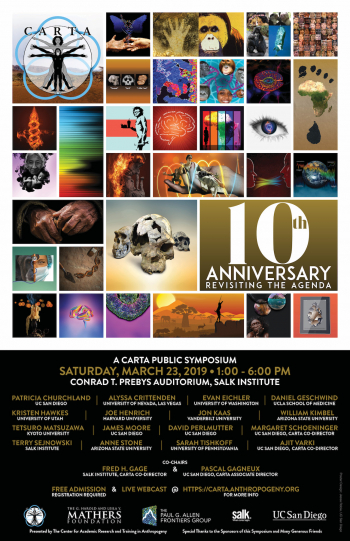CARTA 10th Anniversary: Revisiting the Agenda
Fred Gage, Salk Institute for Biological Studies
Pascal Gagneux, UC San Diego
Summary
More than 20 years ago, a small group of La Jolla academics began periodic meetings for transdisciplinary discussions on anthropogeny (explaining the origin of humans)––an effort that blossomed into an international intellectual collaborative organized by UC San Diego and the Salk Institute as the Center for Academic Research and Training in Anthropogeny (CARTA). At the formal opening of CARTA just over 10 years ago a group of CARTA leaders and advisors attempted to “define the agenda”. Much additional relevant information has since emerged, and an expanded group of experts will now revisit the agenda by addressing the following questions on a broad array of selected topics: What do we know for certain? What do we think we know? What do we need to know? How do we proceed?––Effectively, a whirlwind tour of many but not all approaches to anthropogeny.
Anniversary banners were created especially for this event to represent the 10th Anniversary Celebration, CARTA Supporters, The Evolution of CARTA, Graduate Specialization in Anthropogeny, and Visionaries Who Shaped CARTA (In Memoriam).
Media for each talk can be played by clicking on icons in the table below, or by clicking on the individual talk titles below and then the attachment file at the bottom of the page.
| Speakers | Media | Session |
|---|---|---|
 Fred Gage  Elizabeth Simmons  David Brenner |
|
Opening Remarks |
 Tetsuro Matsuzawa |
|
Comparative Cognition in Primates Humans are a member of the order PRIMATES that has 447 species in the recent categorization. Among them, the hominoid family consists of 4 genera: humans, chimpanzees, gorillas, and orangutans. I have compared the cognitive function in humans and chimpanzees, who share a common ancestor 5-7 million years ago. Our laboratory study is known as the Ai-project, and our field study has been carried out in Bossou-Nimba, Guinea-Conakry, West Africa. Humans and chimpanzees are similar at early... read more |
 James Moore |
|
Behavior & Ecology The Matrix of Comparative Anthropogeny (MOCA, https://carta.anthropogeny.org/moca) lists 72 topics under the domains of Behavior and Ecology, but this greatly underestimates the role of behavior and ecology in hominin evolution. For example, the genetical, physiological and anatomical traits underlying bipedalism all probably owe their evolution to a behavioral change in an ancestor that created selection pressures favoring bipedal locomotion. Much of our understanding of behavior has relied... read more |
 William Kimbel |
|
Paleoanthropology & Comparative Anatomy That humans and chimpanzees shared a most recent common ancestor during the late Miocene of Africa is supported by both molecular and fossil evidence, and is beyond serious doubt. Likewise, there is no question that over the course of human evolution, virtually every anatomical/behavioral system (cognitive, reproductive, locomotor, dietary, social, technological) has been substantially refashioned relative to potential ancestral conditions, with dramatic consequences for our life-history. Much... read more |
 Margaret Schoeninger |
|
Nutrition & Paleodiet Over the last 10 years, the fascination for identifying the ‘Natural Human Diet’ has expanded beyond anything imagined by Eaton and Konner who authored the first paper on Paleolithic Nutrition. The publication of Paleodiet and Paleonutrition cookbooks has exploded, almost exponentially although the science underlying these diets is not always very convincing. Over the same period, we have seen another explosion in the scientific literature on the diets of some fossil members of our lineage... read more |
 Evan Eichler |
|
Comparative Genomics Huxley and Darwin were among the first to appreciate the close evolutionary relationship of humans and other African great apes but also to ponder what genetic changes might make us human. Initial comparisons of human and chimpanzee genes, however, showed little difference (>99% identical) despite the numerous adaptations that must have occurred on various ape lineages. Most comparative genetic studies over the last two decades have emphasized subtle regulatory differences as underlying most... read more |
 Anne Stone |
|
Ancient DNA of Humans and Their Pathogens Advances in method of ancient DNA analysis over the past ten years have transformed our views of human interactions and migrations as well as of the evolutionary dynamics of several of our pathogens. We now know that admixture among archaic and modern humans was common and that human populations have been quite dynamic, both in terms of migrations and admixture and in terms of rapid allele changes that enable environmental adaptation. Questions that remain include what was the role of selection... read more |
 Sarah Tishkoff |
|
Human Population Genetics and Origins Africa is thought to be the ancestral homeland of all modern human populations. It is also a region of tremendous cultural, linguistic, climatic, and genetic diversity. Despite the important role that African populations have played in human history, they remain one of the most under-represented groups in human genomics studies. A comprehensive knowledge of patterns of variation in African genomes is critical for a deeper understanding of human population history in Africa and the genetic... read more |
 Ajit Varki |
|
Comparative Medicine Long-term studies of disease incidence and pathophysiology in captive non-human primates have shed much light on human ailments. Much less attention has been paid to disease states that appear distinctly human and are not explained by anatomical differences. Ongoing comparative biomedical studies of humans and other living hominids (particularly chimpanzees, and the other "great apes”) have revealed many surprising examples of such disease differences. Conversely, there appear to be some... read more |
 Daniel Geschwind |
|
Mental Disease One model of neuropsychiatric disease is that risk for these illnesses is heavily intertwined with human brain evolution and therefore, at least partially, a consequence of factors that underlie distinct human cognition and behavior. We know that many of aspects of human cognition and behavior, as well as brain structure are highly heritable, while also subject to major environmental effects, and include factors that may also predispose to common human disorders. Advances in understanding the... read more |
 Kristen Hawkes |
|
Hunter-Gatherers/ Life History & Reproduction Humans evolved long before farming and herding began about 10,000 years ago. Where people now depend on wild foods, their practices are an “experimental opportunity” to discover how foraging for a living actually works: the problems and solutions, and especially how those vary by sex, age, and local socioecology. Of course regional non-foraging political systems, trade with non-foraging neighbors, and recent technology - like motor vehicles and fire arms - commonly alter daily tradeoffs. But... read more |
 Alyssa Crittenden |
|
Parenting and Child Development Our species is characterized by extraordinary biological success. We have successfully populated all corners of the planet, calling a wide array of habitats in wildly different ecosystems ‘home’. This remarkable success is not only a consequence of our distinct life history characteristics, but is intricately tied to our ability to cooperate with one another. The evolution of human motherhood tells a different story from that of our closest living relatives, the great apes. We have a... read more |
 Katerina Semendeferi |
|
Comparative Brain Anatomy The focus will be on what we now know and what we want to know about the functional organization of the human brain and especially human neocortex. We know that humans have the largest brain and more neocortex of all primates, and likely the most neurons in neocortex, which constitutes 80% of our brain. This large cortex is divided into more areas (the organs of cortex) than in any other primate (about 200 per hemisphere), with greater functional and anatomical specializations than any other... read more |
 David Perlmutter |
|
Language Combinatoriality in the evolution of human language What is the question to ask about the evolution of human language? We know for certain that there is no way to reconstruct an original language or protolanguage by tracing contemporary languages back in time. There have been a number of proposals about how human language originated. Here we focus on how language came to have the form it has, concentrating on phonology, the combinatorial system that combines meaningless speech sounds into... read more |
 Terry Sejnowski |
|
Computational Neuroscience Ten years, ago we simulated small network models of the cortex and other parts of the brain and demonstrated that they could account for basic aspects of perception, working memory and decision making. However, these were toy models compared to real brain circuits, and many aspects of cognition, such as language, remained a mystery. Two revolutions have occurred in the last decade that are rapidly opening up a new era. In neuroscience, new optogenetic tools have made it possible to record from... read more |
 Joseph Henrich |
|
Cultural Evolution and Dual Inheritance To seat humans within the natural world while recognizing our peculiar attributes, evolutionary researchers have increasingly recognized that humans—from our anatomy and physiology to our psychology and behavior—are the product of at least two distinct, but intertwined, inheritance systems, one based on genes and another on culture. To understand the emergence of our cultural inheritance system, much research now demonstrates how natural selection has shaped our attention, memory and motivation... read more |
 Patricia Churchland |
|
Morality & Cooperation Morality is a social behavior seen in mammals, including humans, that depends on an interlocking brain organization shaped by four factors: (1) caring (rooted in attachment to kin and kith, and the pain of isolation), (2) recognition of others’ psychological states (goals, feelings, needs); (3) learning social practices that emerges from the interactions of the reward system, hippocampus, and cortex (4) problem-solving in a social context (figuring out what modifications to a social practices... read more |
 Pascal Gagneux |
|
Closing Remarks |
| Attachment | Size |
|---|---|
| 858.94 KB | |
| 1023.01 KB | |
| 789.94 KB | |
| 1.48 MB | |
| 1.98 MB |
If you enjoy this event, please consider supporting CARTA's quest to explore and explain the human phenomenon.


